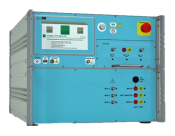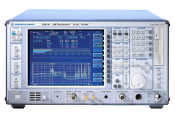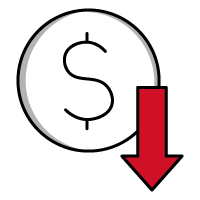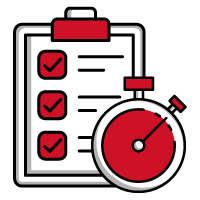Rohde & Schwarz ESCS30
EMI Receiver, 9 kHz - 2.75 GHz
Compliance Testing - EMC, ESD, EMI, RFI >> EMC, EMI and RFI Test Systems and Analyzers >> EMI Receiver, 9 kHz - 2.75 GHzModel: ESCS30
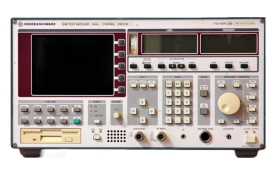
|
Product Overview
The R&S Rohde & Schwarz ESCS30 EMI Receiver is a full compliance test receiver to CISPR and VDE. The ESCS30 performs EMC measurements to standards with outstanding precision, immunity to overload, dynamic range and selection. The built-in time domain analysis allows examination of interference versus time. When used for precertification testing of electrical equipment at the development stage, the ESCS30 detects critical frequencies and serves for product optimization. This reduces development and manufacturing costs, increases price calculation reliability and makes for a successful product.
At a single keystroke the R&S ESCS30 performs complete RFI voltage, RFI power and RFI field-strength measurements. It determines the critical ranges of the spectrum by a prescan measurement using the peak detector. The Max. Hold function allows intermittent interference to be detected. Data-reduction routines serve for determining the frequencies for the final measurement, which is then carried out by means of the quasi-peak and/or average detector with standard-conforming measurement time. This concept saves valuable time that would otherwise be wasted on examining frequency ranges with low emission levels.
The R&S ESCS30 Test Receiver automatically selects the correct CISPR bandwidth for the specific test frequency and makes comparisons with limit lines, eg to EN standard. In case of RFI voltage measurement the phase settings of the lineimpedance stabilization network (LISN) are automatically set. The phase with the highest RFI level is used for final measurement and recorded. For RFI power measurement the ESCS30 interactively searches for the interference maxima. For RFI field-strength measurement the highest emissions are also determined interactively and recorded.
To perform measurements to EN standards the following basic equipment is required:
- RFI voltage measurement:
- EMI Test Receiver ESCS30, LISN (2-line or 4-line V network), printer/plotter
- RFI power measurement:
- EMI Test Receiver ESCS30, absorbing clamp (if necessary, slideway for automatic guidance of clamp), printer/plotter
- RFI field-strength measurement:
- EMI Test Receiver ESCS30, antennas magnetic/electrical/electromagnetic), tripod/mast for fixing the antenna, printer/plotter
RF analysis can be operated in the Spectrum Overview, Scan and Channel Scan modes.
In the Spectrum Overview mode a fast measurement is made of the spectrum between start and stop frequency according to a user-selectable scan table. The minimum measurement time is 50 µs per result and the RF attenuation is preselected. The step size of frequency switching is coupled to the selected IF bandwidth and ensures continuous monitoring of the frequency range. The tracking preselection remains active in the Spectrum Overview mode and ensures the necessary immunity to overload. This type of overview measurement can be switched to continuous scan for qualitative assessment of the spectrum.
In the Scan mode a standard-conforming measurement is again carried out on the basis of a user-selected scan table. The measurement, however, uses selectable step widths in a linear or logarithmic frequency raster. The switchable autoranging function increases the dynamic range and prevents measurement errors that can be caused by overload of the different receiver stages. To reduce the measurement time, peak and average value can be measured simultaneously and displayed as separate traces. CISPR ranges A, B, C and D are predefined as scan ranges and can be activated at a keystroke.
The Channel Scan mode is used if measurements have to be made time and again on the same frequencies as is the case with ready tested DUTs where a scan would not yield any new results. The Channel Scan comprises a list of up to 400 different frequencies at which the level is measured using the selected receiver settings such as measurement time, bandwidth and detector.
The time domain analysis of R&S ESCS30 allows the time behaviour of interference to be determined. It is also very expedient for correct setting of receiver measurement time for RF analysis. The user can determine whether narrowband interference fluctuates and the degree of fluctuation, and whether it is amplitude-modulated. Furthermore the pulse rate of broadband interference can be measured. The measurement time is correct if it is greater than or equal to the reciprocal value of the pulse rate. Devices with thermostatic or microprocessor control generate discontinuous interference. Therefore CISPR14 and EN55014 specify limit values for the RFI voltage with clickrate weighting in the range 0.15 to 30 MHz. Click interference frequently occurs only at long time intervals. In the course of time domain analysis with a peak detector ESCS30 allows the signal to be measured with quasipeak and average detector. Together with the internal trigger that starts the measurement only when a selectable threshold is exceeded, this combination affords time-saving automatic measurement with clear result display (FIG 3). The time domain analysis with resolution of 100 µs meets the accuracy requirements for pulse-duration measurements. Up to 30,000 results can be stored and zoomed with the marker function for detailed investigation.
An important tool for identifying signals in the receive frequency range is IF spectrum analysis with realtime display. A display range between 10 kHz and 10 MHz is selected for the chosen receive frequency and the signal is assessed using a resolution bandwidth of 1, 3 or 10 kHz. The strength of IF analysis is in the fast determination of interference signals.
Characteristics and specificatioins of the Rohde & Schwarz ESCS30 EMI Receiver:
- Fully compliant to CISPR16-1 and VDE0876
- Integrated preselector
- Level measurement range -38 dBµV to +137 dBµV
- For all commercial EMI standards such as CISPR, EN, ETS, FCC, ANSI C63.4, VCCI and VDE
- Automatic overload detection
- measurement uncertainty
- ten integrated preselectors
- selectable preamplifier 10 dB
- CISPR bandwidths 200 Hz, 9 kHz, 120 kHz, 1 MHz
- detectors (peak, average, quasipeak) with parallel output of results and bargraph display on colour monitor
- direct selection of CISPR measurement ranges with bandwidth, step width and measurement time
- automatic scan of frequency ranges and lists with up to 400 different frequencies
- automatic level calibration and builtin selftest function
- macros for RFI voltage, RFI power and RFI field-strength measurements
- nonvolatile storage of complete instrument setups as well as limit lines and frequency-dependent correction factors of antennas and accessories
- storage of results, limit and correction values on built-in 3.5“ disk drive
- time domain analysis with display range from 5 ms to 1 h, manual trigger (internal and external), userselectable zooming of up to 30,000 measured values
- IF spectrum analysis with resolution of 1, 3 or 10 kHz over a display range from 10 kHz to 10 MHz (option)
- 9 kHz to 2750 MHz tracking generator (option).
REQUEST A QUOTE
| Testimonials |
|
Wow, you are good! Thanks for all the information and thank you for your help! Much appreciated! -- Carolyn Maryland |




